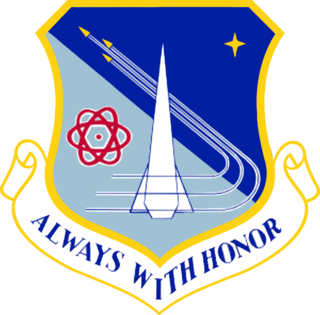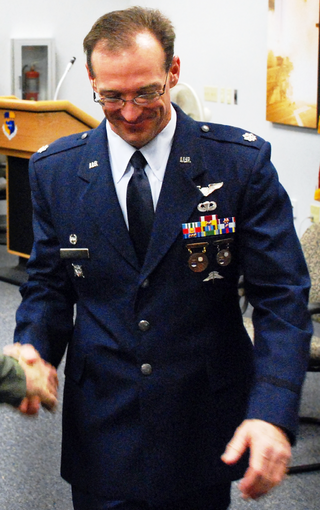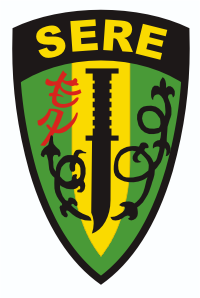
Lackland Air Force Base is a United States Air Force (USAF) base located in Bexar County, Texas, United States. The base is under the jurisdiction of the 802d Mission Support Group, Air Education and Training Command (AETC) and an enclave of the city of San Antonio. It is the only site for USAF and United States Space Force enlisted Basic Military Training (BMT).

Kirtland Air Force Base is a United States Air Force base. It is located in the southeast quadrant of the Albuquerque, New Mexico, urban area, adjacent to the Albuquerque International Sunport. The base was named for the early Army aviator Col. Roy C. Kirtland. The military and the international airport share the same runways, making ABQ a joint civil-military airport.
Camp Perry is a National Guard training facility located on the shore of Lake Erie in northern Ohio near Port Clinton. In addition to its regular mission as a military training base, Camp Perry also boasts the second largest outdoor rifle range in the world after the NRA Whittington Center in Raton, New Mexico. The firing is done in the direction of the open water of the lake, that lies just beyond an earthen berm and the targets.

The Air Education and Training Command (AETC) is one of the nine Major Commands (MAJCOM) of the United States Air Force (USAF), reporting to Headquarters, United States Air Force. It was established 1 July 1993, with the realignment of Air Training Command and Air University.

The Air Force Materiel Command (AFMC) is a Major Command (MAJCOM) of the United States Air Force (USAF). AFMC was created on July 1, 1992, through the amalgamation of the former Air Force Logistics Command (AFLC) and the former Air Force Systems Command (AFSC).

Officer Training School (OTS) is a United States Air Force and United States Space Force commissioning program located at Maxwell Air Force Base in Montgomery, Alabama.

Badges of the United States Air Force are specific uniform insignia authorized by the United States Air Force that signify aeronautical ratings, special skills, career field qualifications, and serve as identification devices for personnel occupying certain assignments.
The Air Force Specialty Code (AFSC) is an alphanumeric code used by the United States Air Force to identify a specific job. Officer AFSCs consist of four characters and enlisted AFSCs consist of five characters. A letter prefix or suffix may be used with an AFSC when more specific identification of position requirements and individual qualifications is necessary. The AFSC is similar to the Military Occupational Specialty Codes used by the United States Army and the United States Marine Corps or enlisted ratings and USN officer designators and Naval Officer Billet Classifications (NOBCs) used by the United States Navy and enlisted ratings and USCG officer specialties used by the United States Coast Guard. The United States Space Force equivalent is known as the Space Force Specialty Code (SFSC).

The United States Air Force Security Forces (SF) are the ground combat force and military police service of the U.S. Air Force and U.S. Space Force. The USAF Security Forces were formerly known as Military Police (MP), Air Police (AP), and Security Police (SP) at various points in their history. Due to its significant ground combat mission, Security Forces are sometimes regarded as Air Force infantry within the Air Force and were formed on the premise of being the Air Force's "Marine Corps", in that they would provide security for the Air Force similar to how the Marines provide security for the Navy.

Survival, Evasion, Resistance, and Escape (SERE) is a training program, best known by its military acronym, that prepares U.S. military personnel, U.S. Department of Defense civilians, and private military contractors to survive and "return with honor" in survival scenarios. The curriculum includes survival skills, evading capture, application of the military code of conduct, and techniques for escape from captivity. Formally established by the U.S. Air Force at the end of World War II and the start of the Cold War, it was extended to the Navy and United States Marine Corps and consolidated within the Air Force during the Korean War with greater focus on "resistance training".

The Air Training Command (ATC) is a former United States Air Force (USAF) Major Command designation. It was headquartered at Randolph Air Force Base, Texas, but was initially formed at Barksdale Air Force Base, Louisiana. It was re-designated as Air Education and Training Command (AETC) following a merger with Air University (AU) on 1 July 1993.

Special Reconnaissance (SR)—formerly Special Operations Weather Technician or Team (SOWT)—is conducted by trained Air Force personnel assigned to Special Tactics Squadrons of the United States Air Force Special Operations Command who operate deep behind enemy lines to conduct covert direction of air and missile attacks, place remotely monitored sensors, and support other special operation units. Like other special operations units, SR units may also carry out direct action (DA) and unconventional warfare (UW), including guerrilla operations. As SOWTs they were tactical observer/forecasters with ground combat capabilities and fell under the Air Force Special Tactics within the Air Force Special Operations Command (AFSOC). The mission of a Special Operations Weather Technician was to deploy by the most feasible means available into combat and non-permissive environments to collect and interpret meteorological data and provide air and ground forces commanders with timely, accurate intelligence. They collect data, assist mission planning, generate accurate and mission-tailored target and route forecasts in support of global special operations, conduct special weather reconnaissance and train foreign national forces. SOWTs provided vital intelligence and deployed with joint air and ground forces in support of direct action, counter-terrorism, foreign internal defense, humanitarian assistance, special reconnaissance, austere airfield, and combat search and rescue.

The Special Missions Training Center (SMTC), also known as Joint Maritime Training Center (JMTC), is a joint United States Coast Guard, Navy, and Marine Corps training facility located on Camp Lejeune, North Carolina. SMTC's mission is to provide relevant and credible Maritime Security Training and Operational Testing and Evaluation in support of Department of Defense and Department of Homeland Security missions. SMTC comprises four main divisions: Weapons, Port Security, Engineering / Logistics, and Fast Boat.

The 37th Training Wing is a unit of the United States Air Force assigned to the 2nd Air Force and the Air Education and Training Command. As the host unit to Lackland Air Force Base, Joint Base San Antonio, Texas, the 37th TRW is the predominant unit on the installation and is the largest training wing in the USAF. Known as the "Gateway to the Air Force", the 37th Training Wing's replaced the Lackland Training Center as the single basic military training for the USAF.

Munitions Systems specialists are enlisted airmen of the U.S. Air Force tasked with protecting, handling, storing, transporting, arming/disarming, and assembly of non-nuclear munitions. The Munitions Systems career field is commonly referred to by airmen as "AMMO".

United States Air Force Basic Military Training is a seven-week program of physical and combat training required in order for an individual to become enlisted into the United States Air Force, Air Force Reserve, Air National Guard and United States Space Force. It is located at Lackland Air Force Base in San Antonio, Texas.
RNZAF Security Forces is the Royal New Zealand Air Force unit responsible for base security, ground defence, weapons training, and Air Transport Security on RNZAF aircraft. RNZAF Security Forces operates under the RNZAF Operations Squadron.

A United States Air Force Tactical Air Control Party, commonly abbreviated TACP, is an individual or team of United States Air Force Special Warfare Airmen with AFSC 1Z3X1, who are aligned with conventional, Special Operation Forces, and Tier 1 combat maneuver units. They provide precision terminal attack control and terminal attack guidance of U.S. and coalition fixed- and rotary-wing close air support aircraft, artillery, and naval gunfire; establish and maintain command and control (C2) communications; and advise ground commanders on the best use of air power.

The Master-at-Arms (MA) rating is responsible for law enforcement and force protection in the United States Navy—equivalent to the United States Army Military Police, the United States Marine Corps Military Police, the United States Air Force Security Forces, and the United States Coast Guard's Maritime Law Enforcement Specialist. It is one of the oldest ratings in the United States Navy, having been recognized since the inception of the U.S. Navy.















